1 of 45
Downloaded 51 times
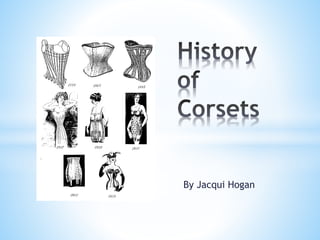
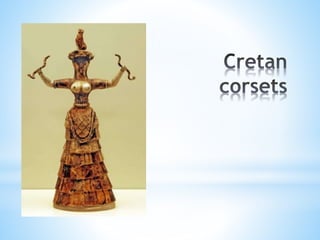
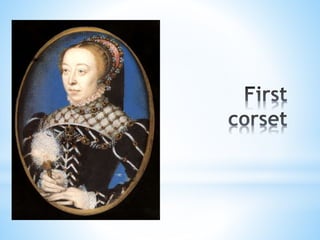

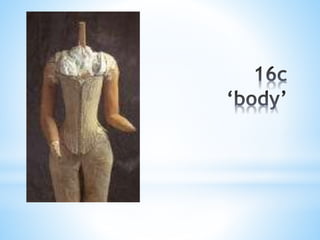
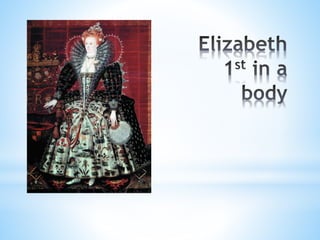
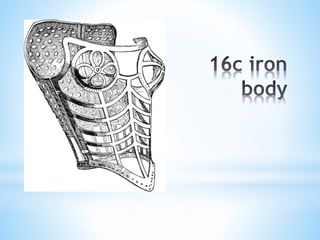


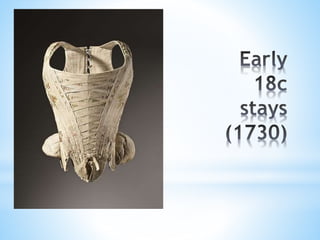

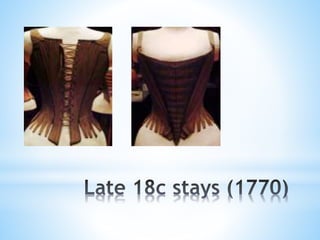

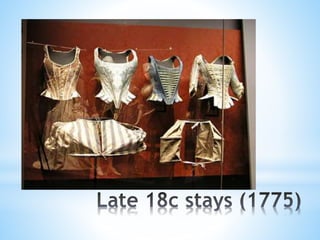

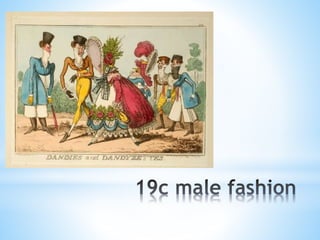
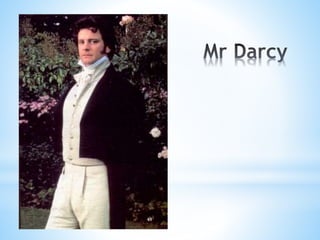
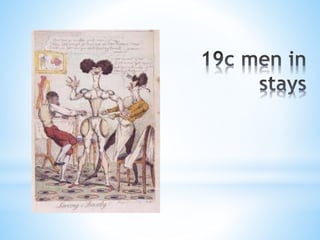
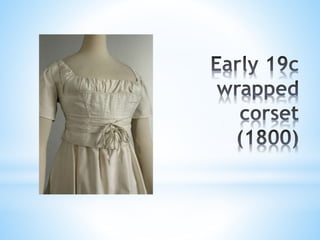
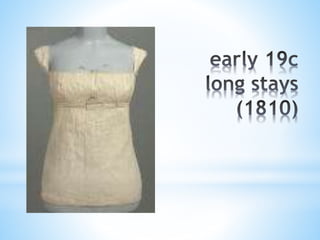
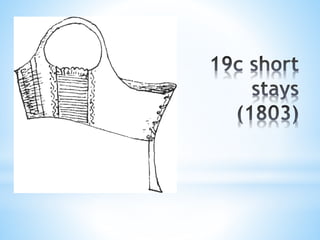
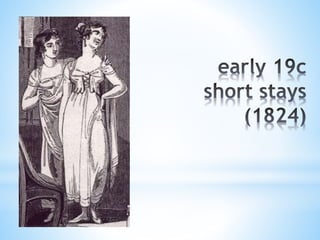
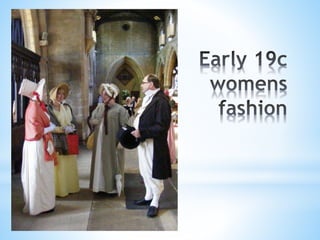
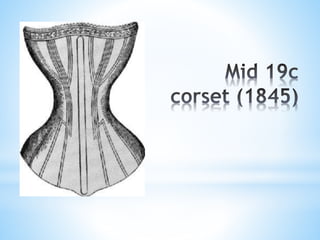


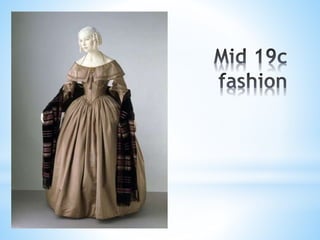
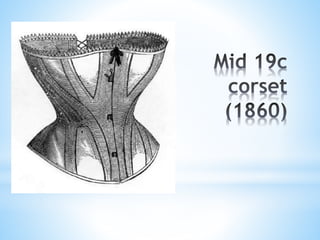

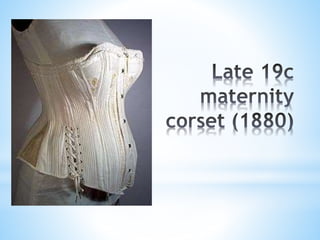

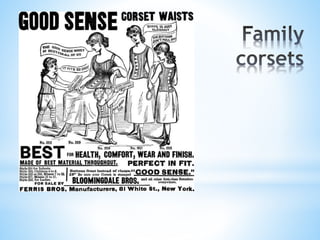

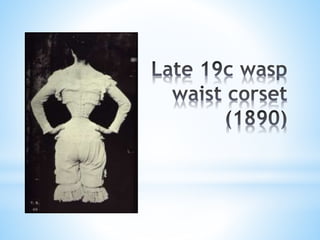
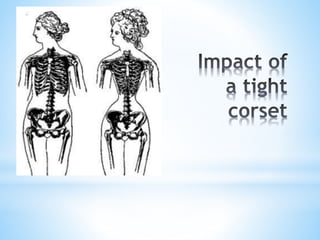
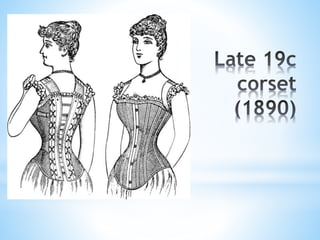
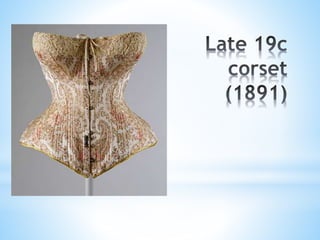
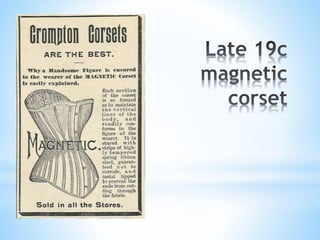
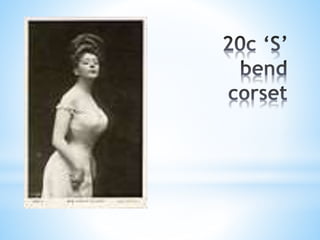

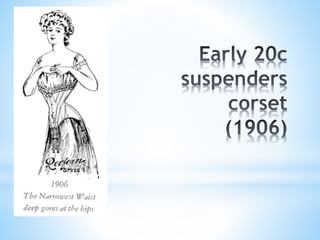
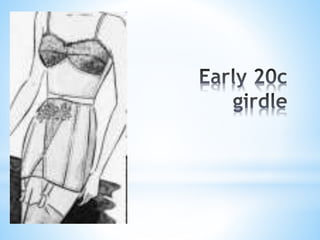

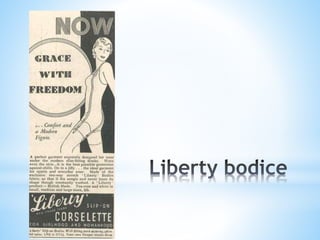

Ad
Recommended
History of the Corset
History of the Corsetmwett001
╠²
This document discusses the history and use of corsets from ancient times through the modern era. It describes how corsets became popular during the Victorian era as a way to achieve an hourglass figure through tight lacing. However, this led to many health issues and their use declined in the early 20th century as women's roles changed. While corsets no longer compress internal organs, some are still worn today as lingerie or for their historical image rather than as daily wear.Embroidery of kutch
Embroidery of kutchAnjali Savla
╠²
This document provides information on various types of embroidery techniques found in Asia, including mirror work, soof embroidery, kharek embroidery, pakko embroidery, rabari embroidery, jats embroidery, and mutwas embroidery. The summary highlights that these embroidery styles originate from communities in places like Gujarat, Rajasthan, Sindh, and Kutch and involve the use of mirrors, geometric patterns, and motifs inspired by nature, mythology, and daily life. The embroidery is used to create various products like clothes, bags, caps, and home decor items.THE TRADITIONAL KALAMKARI
THE TRADITIONAL KALAMKARIKinjal Rate
╠²
The traditional Kalamkari art form involves hand painting or block printing cotton fabrics with natural dyes. It originated in India as early as the 10th century through Persian and Indian trade relationships. Two main styles developed - the Srikalahasti style from Andhra Pradesh focuses on Hindu mythology themes using freehand drawing, while the Machilipatnam style from Golconda was influenced by Persian motifs using carved blocks for outlines followed by freehand details. The traditional multi-stage process involves preparing, bleaching, and repeatedly dyeing and washing the fabric with plant-based dyes to create designs in different colors.What is boutique
What is boutiqueHindustan University
╠²
A boutique is a small specialty shop that sells stylish clothing, accessories, or other luxury goods. Boutiques often focus on a particular style. To start a boutique, you can look into franchising opportunities, source wholesale suppliers to start from scratch, and get a merchant account for credit card processing. The key steps to opening a boutique include creating a vision for what you want it to be through images and research, and developing a unique brand identity through the store name, logo, and focused product selection.Fashion design portfolio
Fashion design portfolioayush Kumar
╠²
Ayush presents his portfolio showcasing his experience and skills in fashion design. He completed his Bachelors in Fashion Design from NIFT Kolkata in 2020. His design philosophy is influenced by luxury and creating wearable art that depicts personal identity. He has worked for several fashion brands in roles including designing, merchandising, and production. Ayush has strong skills in design, pattern making, garment construction, and software programs like Adobe Photoshop. He has undertaken various projects demonstrating his abilities in areas like knitwear, surface development, crafts, and children's fashion. Ayush aims to continue developing innovative and creative designs that showcase beauty, luxury and classic styles.textile design
textile designshiveyb
╠²
The document traces the evolution of textiles from prehistoric times to the present day. It discusses how early humans used mammoth skins sewn together for clothing in 26,000 BC. In ancient Egypt in 5500 BC, evidence exists for the production of linen cloth. In China between 500-300 BC, silk production began and was used to create Hanfu tunics. During the Roman period from 27 BC to AD 476, linen weaving techniques improved and typical garments included the peplos robe. During the Middle Ages from 1200-1400 AD, wool became commonly used and weaving techniques advanced.Mirror work of rajasthan
Mirror work of rajasthanNilima Gavit
╠²
Mirror work originated in 13th century Persia and was brought to India during the Mughal era by traders and travelers. It involves decorating fabric with small pieces of mirror or mica in various shapes and sizes using stitches. There are three main types: hand blown glass shisha, machine cut glass shisha, and shisha embroidery. In traditional Rajasthani clothing, mirror work embroidery is used to represent the landscapes of India and ward off evil spirits according to Islamic beliefs. Each Indian state has developed its own unique styles of mirror work featuring motifs, colors, and shapes inspired by nature.Draping terminology
Draping terminologyShefali Verma
╠²
This document provides information about the draping process in fashion design. It defines draping as positioning and pinning fabric onto a dress form to develop the structure of a garment. Draping allows designers to sculpt one-of-a-kind designs through direct manipulation of the fabric. It is commonly used for couture and high-end pieces. The document also outlines various draping techniques, terms, tools used, and the steps involved in draping.Kashimiri Kashida Beauty of Indian Embroideries
Kashimiri Kashida Beauty of Indian EmbroideriesAmbika Rathore
╠²
Kashida embroidery, originating in the Mughal period in Kashmir, features a variety of stitches and commonly used fabrics such as silk, wool, and cotton. Drawing inspiration from nature, motifs include birds, flowers, and fruits, with color palettes consisting of white, green, purple, and more. While traditionally applied to shawls, this intricate embroidery is now also used on various clothing and home decor items.Embroidery
EmbroiderySarwat Shabbir
╠²
This document discusses the art of fabric embellishment through embroidery in India. It provides background on the origins and techniques of Indian embroidery. Specific embroidery styles that are discussed include Mughal court embroideries from the 17th-18th centuries, various types of zari embroideries including zardozi and kalabutta, regional styles like applique and ralli from Rajasthan, Chamba rumals, Lucknow chikankari, and Sindhi ajrak cloth. The document emphasizes that Indian embroidery reflects diverse cultural influences and traditions across regions.applique work
applique worksahanihossain
╠²
This document provides information about applique work including:
1) Applique involves attaching pieces of fabric onto a larger background fabric to form patterns or pictures. It differs from patchwork which involves piecing together small fabric pieces into a whole.
2) Various techniques for applique are described including hand applique, machine applique, and fused applique. Different edge finishes for applique shapes are also outlined.
3) Traditional applique work from Pipli, Orissa is discussed, noting its origins in religious ceremonies and motifs used including flora, fauna, and mythology.Art and Fashion
Art and FashionKate Marielle Balueta
╠²
The document discusses the concept of fashion as both a style and an art form that incorporates skill, imagination, and creativity. It highlights modern Filipino fashion artworks, specifically the designs of Tippi Ocampo and Malou Castillejos, showcasing their innovative use of materials and inspiration from cultural elements. Additionally, it references historical foreign fashion artworks, focusing on notable figures such as Empress Elisabeth of Austria and designers like Charles Frederick Worth and Paul Poiret.Historic Textiles
Historic Textiles Himanshu Maurya
╠²
The document provides a comprehensive overview of the history of textiles across various civilizations, including prehistoric weaving, ancient cultures in the Near East, India, Egypt, China, Persia, Turkey, and Africa. It discusses the evolution of textile production methods, significant materials like wool and silk, and the cultural significance of textiles in different societies over millennia. Key innovations and regional specialties highlight the global development of textile craftsmanship and trade from ancient times to the modern era.Fashion forecasting
Fashion forecastingSimran Parmar
╠²
Fashion forecasting involves predicting trends and styles that customers will want to purchase seasons in advance. It is necessary because the fashion industry works well ahead of seasons to manufacture products on time. Forecasting includes studying market conditions, lifestyles, past data, street fashion, and designer collections. Understanding target customers through research like surveys and focus groups is also important for forecasting. Developing a calendar with key event dates helps coordinate manufacturing and delivery to have the right products at the right time.Historical perspectives of kalamkari craftsmanship
Historical perspectives of kalamkari craftsmanshipHindustan University
╠²
Kalamkari is an ancient craft from Andhra Pradesh, combining painting and block-printing on cotton using natural dyes derived from various sources. Originating during the era of Sri Krishnadevaraya, it involves a meticulous process of 17 to 23 steps, showcasing vibrant motifs often depicting deities and scenes from Hindu epics. Despite facing decline due to technological advancements, kalamkari has seen a revival through modern fashion, re-establishing its significance in contemporary culture.Chikankari
ChikankariNidhi Nayak
╠²
This document is a project dissertation submitted by Ms. Nidhi Nayak on Chikankari, a traditional embroidery art from Lucknow, India. It provides an introduction to Chikankari and discusses its origins in Persia and development in Lucknow. The dissertation also examines the history of Chikankari, describes the various stitching techniques used, and outlines the traditional production process of block printing designs, embroidery, and washing the finished textiles.Burberry - Brand Study & Wallpaper, Window Display, Prop Design
Burberry - Brand Study & Wallpaper, Window Display, Prop DesignAkansha Choudhary
╠²
Burberry is a British luxury fashion house known for its trench coats and distinctive check pattern, founded in 1856 by Thomas Burberry. The brand emphasizes a high standard of customer service and innovative store designs that reflect its heritage while incorporating modern elements. Recent initiatives include themed collections and immersive shopping experiences that blend digital and physical interactions, especially evident in their flagship stores.ancient fashion history
ancient fashion historymangala.shetty
╠²
The document provides a historical overview of clothing in ancient India from the Indus Valley civilization through the Gupta period. Key developments include:
- Rudimentary clothing in the Indus Valley civilization from 5000 years ago including draped fabrics and body adornments.
- Introduction of the dhoti as the first form of lower body clothing during the Vedic period around 3500 years ago.
- Influence of foreign invaders like the Greeks, Kushans, and Persians from 2300-1800 years ago bringing new textiles, dyeing techniques, and stitched garments.
- Emergence of regional variations between the clothing of North and South India and development of early sPpt of accessories
Ppt of accessoriesJean leo
╠²
TheCustomClothing is an Indian company that produces high quality, customized wool accessories like ties, handbags, and scarves. They control the entire production process from spinning wool yarn to the finished product in their facility in Amritsar. They offer a variety of fashion accessories made from wool to help customers redefine their style, including ties in various patterns, tote bags, and 100% wool scarves. Their production process combines modern technology with traditional expertise while using environmentally safe practices. fashion illustration
fashion illustrationKirtiBana
╠²
The document provides an overview of fashion illustration, including its history, process, tools used, and key steps. Fashion illustration has existed for around 500 years to communicate fashion ideas visually. A designer starts with inspiration and rough sketches, then transfers sketches to more detailed croquis adding texture, color, patterns and details using tools like sketchbooks, pencils, pens, and watercolors. Understanding proportions and poses is key to bringing sketches to life and accurately placing clothing details like style, fabric, and folds.Modernizing the traditional phulkari
Modernizing the traditional phulkarimominaMT
╠²
This document discusses the traditional Phulkari embroidery craft of Punjab. It originated in the 15th century and was done by women in their homes using silk threads to embroider flowers and motifs on cotton fabric. It was seen as a sign of love and was given as gifts for special occasions like marriages. However, after the India-Pakistan partition in the 20th century, the art form declined as it was mostly a domestic craft passed down generations. Now it has seen commercialization but lost some personal charm. The document explores traditional colors, patterns and the history and importance of Phulkari in Punjab culture.CLOTHING IN ANCIENT EGYPT: HISTORY OF FASHION
CLOTHING IN ANCIENT EGYPT: HISTORY OF FASHIONShramana Mullick
╠²
The document discusses clothing and fashion in ancient Egypt. It describes that:
1) Linen was the most common fabric worn by both men and women in Egypt as it was lightweight and helped keep people cool in the hot climate. Men typically wore a knee-length kilt called a schenti, while women wore a simple, ankle-length sheath dress.
2) Clothing was usually left in the natural color of linen but some dyes were used. Jewelry, wigs, eye makeup, and sandals were also worn. Clothing differed between social classes with the upper class having more ornate styles.
3) Royal clothing like that of pharaohs was elaborately1900 to 1950s_fashion_history
1900 to 1950s_fashion_historyStoutl
╠²
This document provides an overview of fashion history from 1900-1950. It summarizes trends for each decade including the early 1900s emphasis on softer silhouettes, the introduction of the three-piece suit for men. The 1920s saw a tubular silhouette and the rise of the flapper style. The 1930s brought classic styles like the shirtwaist dress due to the Depression. World War II influenced 1940s fashion with utility fabrics and padded shoulders for women.Fabric weave
Fabric weaveArpita Pari
╠²
This document summarizes different types of weaves (plain, twill, satin, etc.), knitting structures (rib, interlock, purl), and various defects that can occur in weaving, knitting, dyeing, printing and finishing of fabrics. It provides details on the construction, properties, end uses and raw materials for different weaves and knitting stitches. It also lists and describes common defects in weaving like bias fabric, bowed fabric. Defects in knitting, dyeing, printing and finishing are also outlined.Textile designing techniques
Textile designing techniquesVanali Ballikar
╠²
Textile designing involves applying patterns and designs to fabric surfaces. There are several techniques for constructing and decorating fabric, including weaving, knitting, printing, and dyeing. Common printing methods are hand block printing, roller printing, screen printing, and 3D printing, which apply colored designs to fabric. Dyeing techniques like tie-dye, resist dyeing, and discharge dyeing impart patterns by controlling how the fabric is immersed in dye baths or preventing dye from reaching all areas.Historical over view of fashion forecasting
Historical over view of fashion forecastingtinsayeasfaw
╠²
1) The Textile Color Card Association of America was one of the first organizations to formally forecast women's fashion trends and colors to help standardize mass production in the post-World War II era.
2) Fashion cycles typically progress from introduction to growth, maturity, and decline as styles become more widely adopted and produced.
3) Consumers can be categorized based on their willingness to adopt new innovations, from innovators and early adopters who try new styles early, to early and late majorities that follow trends more gradually.Types of traditional indian textile
Types of traditional indian textileparul pundir
╠²
This document provides an overview of various embroidered textiles from different regions of India. It describes 14 types of embroidery - Kashida, Phulkari, Chamba Rumal, embroidery from Gujarat, Parsi embroidery, Chikankari, Phool Patti ka Kaam, Zardozi, Kasuti, Lambadi embroidery, Kantha, Sujani and Pipli applique. For each embroidery type, it discusses the region it is practiced in, the stitches and motifs used, and its traditional and modern uses. The embroideries are classified based on the geographical region - Northern, Western, Central and Southern India and Eastern India. Detailed information on the style and techniques is providedFashion terminology
Fashion terminology Mohaddesa Dehghani
╠²
The document defines many fashion and apparel terms including style, fashion, costume, item, soft goods, apparel, garment, wardrobe, accessories, coordinates, separates, silhouette, hi fashion, designer label, mass market fashion, fad, craze, classic, knock offs, pret a porter, couture, bespoke, haute couture, avant garde, atelier, boutique, toile, draping, pattern grading, trimmings, details, woven, knitted, non woven, motif, repeat, pattern, tailored garments, composite, visual merchandising, stylist, consumers, retail store, seams, fit, darts, bodice,Corsets
Corsetsharrisarcher23
╠²
The document provides information about Corsets4u, an online retailer of corsets and related items. It lists their website and phone number. Sections describe various products for sale including underbust corsets, fashion corsets, bustiers, value corsets, stockings, gloves, skirts, plus size corsets. It also covers returns/exchanges, postage costs and delivery times, and contact details.Corset slideshow
Corset slideshowJamieMF
╠²
This document summarizes the author's experience with different types of corsets from various retailers. It provides photos comparing a plastic-boned bustier, a basic steel-boned corset from CorsetStory, a homemade corset, and higher-quality corsets from Gallery Serpentine and Canal Boat Trading. The author explains that poorly made corsets from retailers like CorsetStory do not have curvy patterns and do not properly shape the waist, instead causing discomfort. In contrast, well-made corsets from reputable sellers are comfortable and define the waist dramatically. The author advises supporting corset makers with reasonable prices and curvy patterns that provide a better fit.More Related Content
What's hot (20)
Kashimiri Kashida Beauty of Indian Embroideries
Kashimiri Kashida Beauty of Indian EmbroideriesAmbika Rathore
╠²
Kashida embroidery, originating in the Mughal period in Kashmir, features a variety of stitches and commonly used fabrics such as silk, wool, and cotton. Drawing inspiration from nature, motifs include birds, flowers, and fruits, with color palettes consisting of white, green, purple, and more. While traditionally applied to shawls, this intricate embroidery is now also used on various clothing and home decor items.Embroidery
EmbroiderySarwat Shabbir
╠²
This document discusses the art of fabric embellishment through embroidery in India. It provides background on the origins and techniques of Indian embroidery. Specific embroidery styles that are discussed include Mughal court embroideries from the 17th-18th centuries, various types of zari embroideries including zardozi and kalabutta, regional styles like applique and ralli from Rajasthan, Chamba rumals, Lucknow chikankari, and Sindhi ajrak cloth. The document emphasizes that Indian embroidery reflects diverse cultural influences and traditions across regions.applique work
applique worksahanihossain
╠²
This document provides information about applique work including:
1) Applique involves attaching pieces of fabric onto a larger background fabric to form patterns or pictures. It differs from patchwork which involves piecing together small fabric pieces into a whole.
2) Various techniques for applique are described including hand applique, machine applique, and fused applique. Different edge finishes for applique shapes are also outlined.
3) Traditional applique work from Pipli, Orissa is discussed, noting its origins in religious ceremonies and motifs used including flora, fauna, and mythology.Art and Fashion
Art and FashionKate Marielle Balueta
╠²
The document discusses the concept of fashion as both a style and an art form that incorporates skill, imagination, and creativity. It highlights modern Filipino fashion artworks, specifically the designs of Tippi Ocampo and Malou Castillejos, showcasing their innovative use of materials and inspiration from cultural elements. Additionally, it references historical foreign fashion artworks, focusing on notable figures such as Empress Elisabeth of Austria and designers like Charles Frederick Worth and Paul Poiret.Historic Textiles
Historic Textiles Himanshu Maurya
╠²
The document provides a comprehensive overview of the history of textiles across various civilizations, including prehistoric weaving, ancient cultures in the Near East, India, Egypt, China, Persia, Turkey, and Africa. It discusses the evolution of textile production methods, significant materials like wool and silk, and the cultural significance of textiles in different societies over millennia. Key innovations and regional specialties highlight the global development of textile craftsmanship and trade from ancient times to the modern era.Fashion forecasting
Fashion forecastingSimran Parmar
╠²
Fashion forecasting involves predicting trends and styles that customers will want to purchase seasons in advance. It is necessary because the fashion industry works well ahead of seasons to manufacture products on time. Forecasting includes studying market conditions, lifestyles, past data, street fashion, and designer collections. Understanding target customers through research like surveys and focus groups is also important for forecasting. Developing a calendar with key event dates helps coordinate manufacturing and delivery to have the right products at the right time.Historical perspectives of kalamkari craftsmanship
Historical perspectives of kalamkari craftsmanshipHindustan University
╠²
Kalamkari is an ancient craft from Andhra Pradesh, combining painting and block-printing on cotton using natural dyes derived from various sources. Originating during the era of Sri Krishnadevaraya, it involves a meticulous process of 17 to 23 steps, showcasing vibrant motifs often depicting deities and scenes from Hindu epics. Despite facing decline due to technological advancements, kalamkari has seen a revival through modern fashion, re-establishing its significance in contemporary culture.Chikankari
ChikankariNidhi Nayak
╠²
This document is a project dissertation submitted by Ms. Nidhi Nayak on Chikankari, a traditional embroidery art from Lucknow, India. It provides an introduction to Chikankari and discusses its origins in Persia and development in Lucknow. The dissertation also examines the history of Chikankari, describes the various stitching techniques used, and outlines the traditional production process of block printing designs, embroidery, and washing the finished textiles.Burberry - Brand Study & Wallpaper, Window Display, Prop Design
Burberry - Brand Study & Wallpaper, Window Display, Prop DesignAkansha Choudhary
╠²
Burberry is a British luxury fashion house known for its trench coats and distinctive check pattern, founded in 1856 by Thomas Burberry. The brand emphasizes a high standard of customer service and innovative store designs that reflect its heritage while incorporating modern elements. Recent initiatives include themed collections and immersive shopping experiences that blend digital and physical interactions, especially evident in their flagship stores.ancient fashion history
ancient fashion historymangala.shetty
╠²
The document provides a historical overview of clothing in ancient India from the Indus Valley civilization through the Gupta period. Key developments include:
- Rudimentary clothing in the Indus Valley civilization from 5000 years ago including draped fabrics and body adornments.
- Introduction of the dhoti as the first form of lower body clothing during the Vedic period around 3500 years ago.
- Influence of foreign invaders like the Greeks, Kushans, and Persians from 2300-1800 years ago bringing new textiles, dyeing techniques, and stitched garments.
- Emergence of regional variations between the clothing of North and South India and development of early sPpt of accessories
Ppt of accessoriesJean leo
╠²
TheCustomClothing is an Indian company that produces high quality, customized wool accessories like ties, handbags, and scarves. They control the entire production process from spinning wool yarn to the finished product in their facility in Amritsar. They offer a variety of fashion accessories made from wool to help customers redefine their style, including ties in various patterns, tote bags, and 100% wool scarves. Their production process combines modern technology with traditional expertise while using environmentally safe practices. fashion illustration
fashion illustrationKirtiBana
╠²
The document provides an overview of fashion illustration, including its history, process, tools used, and key steps. Fashion illustration has existed for around 500 years to communicate fashion ideas visually. A designer starts with inspiration and rough sketches, then transfers sketches to more detailed croquis adding texture, color, patterns and details using tools like sketchbooks, pencils, pens, and watercolors. Understanding proportions and poses is key to bringing sketches to life and accurately placing clothing details like style, fabric, and folds.Modernizing the traditional phulkari
Modernizing the traditional phulkarimominaMT
╠²
This document discusses the traditional Phulkari embroidery craft of Punjab. It originated in the 15th century and was done by women in their homes using silk threads to embroider flowers and motifs on cotton fabric. It was seen as a sign of love and was given as gifts for special occasions like marriages. However, after the India-Pakistan partition in the 20th century, the art form declined as it was mostly a domestic craft passed down generations. Now it has seen commercialization but lost some personal charm. The document explores traditional colors, patterns and the history and importance of Phulkari in Punjab culture.CLOTHING IN ANCIENT EGYPT: HISTORY OF FASHION
CLOTHING IN ANCIENT EGYPT: HISTORY OF FASHIONShramana Mullick
╠²
The document discusses clothing and fashion in ancient Egypt. It describes that:
1) Linen was the most common fabric worn by both men and women in Egypt as it was lightweight and helped keep people cool in the hot climate. Men typically wore a knee-length kilt called a schenti, while women wore a simple, ankle-length sheath dress.
2) Clothing was usually left in the natural color of linen but some dyes were used. Jewelry, wigs, eye makeup, and sandals were also worn. Clothing differed between social classes with the upper class having more ornate styles.
3) Royal clothing like that of pharaohs was elaborately1900 to 1950s_fashion_history
1900 to 1950s_fashion_historyStoutl
╠²
This document provides an overview of fashion history from 1900-1950. It summarizes trends for each decade including the early 1900s emphasis on softer silhouettes, the introduction of the three-piece suit for men. The 1920s saw a tubular silhouette and the rise of the flapper style. The 1930s brought classic styles like the shirtwaist dress due to the Depression. World War II influenced 1940s fashion with utility fabrics and padded shoulders for women.Fabric weave
Fabric weaveArpita Pari
╠²
This document summarizes different types of weaves (plain, twill, satin, etc.), knitting structures (rib, interlock, purl), and various defects that can occur in weaving, knitting, dyeing, printing and finishing of fabrics. It provides details on the construction, properties, end uses and raw materials for different weaves and knitting stitches. It also lists and describes common defects in weaving like bias fabric, bowed fabric. Defects in knitting, dyeing, printing and finishing are also outlined.Textile designing techniques
Textile designing techniquesVanali Ballikar
╠²
Textile designing involves applying patterns and designs to fabric surfaces. There are several techniques for constructing and decorating fabric, including weaving, knitting, printing, and dyeing. Common printing methods are hand block printing, roller printing, screen printing, and 3D printing, which apply colored designs to fabric. Dyeing techniques like tie-dye, resist dyeing, and discharge dyeing impart patterns by controlling how the fabric is immersed in dye baths or preventing dye from reaching all areas.Historical over view of fashion forecasting
Historical over view of fashion forecastingtinsayeasfaw
╠²
1) The Textile Color Card Association of America was one of the first organizations to formally forecast women's fashion trends and colors to help standardize mass production in the post-World War II era.
2) Fashion cycles typically progress from introduction to growth, maturity, and decline as styles become more widely adopted and produced.
3) Consumers can be categorized based on their willingness to adopt new innovations, from innovators and early adopters who try new styles early, to early and late majorities that follow trends more gradually.Types of traditional indian textile
Types of traditional indian textileparul pundir
╠²
This document provides an overview of various embroidered textiles from different regions of India. It describes 14 types of embroidery - Kashida, Phulkari, Chamba Rumal, embroidery from Gujarat, Parsi embroidery, Chikankari, Phool Patti ka Kaam, Zardozi, Kasuti, Lambadi embroidery, Kantha, Sujani and Pipli applique. For each embroidery type, it discusses the region it is practiced in, the stitches and motifs used, and its traditional and modern uses. The embroideries are classified based on the geographical region - Northern, Western, Central and Southern India and Eastern India. Detailed information on the style and techniques is providedFashion terminology
Fashion terminology Mohaddesa Dehghani
╠²
The document defines many fashion and apparel terms including style, fashion, costume, item, soft goods, apparel, garment, wardrobe, accessories, coordinates, separates, silhouette, hi fashion, designer label, mass market fashion, fad, craze, classic, knock offs, pret a porter, couture, bespoke, haute couture, avant garde, atelier, boutique, toile, draping, pattern grading, trimmings, details, woven, knitted, non woven, motif, repeat, pattern, tailored garments, composite, visual merchandising, stylist, consumers, retail store, seams, fit, darts, bodice,Viewers also liked (15)
Corsets
Corsetsharrisarcher23
╠²
The document provides information about Corsets4u, an online retailer of corsets and related items. It lists their website and phone number. Sections describe various products for sale including underbust corsets, fashion corsets, bustiers, value corsets, stockings, gloves, skirts, plus size corsets. It also covers returns/exchanges, postage costs and delivery times, and contact details.Corset slideshow
Corset slideshowJamieMF
╠²
This document summarizes the author's experience with different types of corsets from various retailers. It provides photos comparing a plastic-boned bustier, a basic steel-boned corset from CorsetStory, a homemade corset, and higher-quality corsets from Gallery Serpentine and Canal Boat Trading. The author explains that poorly made corsets from retailers like CorsetStory do not have curvy patterns and do not properly shape the waist, instead causing discomfort. In contrast, well-made corsets from reputable sellers are comfortable and define the waist dramatically. The author advises supporting corset makers with reasonable prices and curvy patterns that provide a better fit.Corsets
Corsetscorsets4u
╠²
The document discusses how corsets can suit women of all ages and body types. It notes that corsets have a long history dating back to the 16th century and were once used to constrain women's bodies, but modern corsets are designed to beautifully complement female figures. Corsets can be worn for both public and private occasions and come in a wide variety of styles, materials, colors and sizes to suit all tastes. The document encourages women to incorporate corsets into their wardrobes to add sex appeal and spice to their lives.Edi├¦├Żo mercado livre2luciano Pinheiro
╠²
Este documento fornece informa├¦├Ąes sobre corseletes e lingerie ├Ā venda, incluindo pre├¦os, tamanhos dispon├Łveis, formas de pagamento e prazos de entrega. Os produtos s├Żo originais e de alta qualidade, com entrega em at├® 5 dias ├║teis ap├│s a confirma├¦├Żo do pagamento via boleto banc├Īrio ou Mercado Pago.Presentation final
Presentation finaliteclearners
╠²
The document provides a history of corsetry from ancient Minoan times to modern day. It details the evolution of corset design and materials over time, from stiffened fabrics and wood ribs in the 1400s to metal eyelets and bones in later centuries. The tight lacing of corsets was seen as a virtue in wealthy women during the 18th-19th centuries and was believed to support their fragile frames. The health and feminist movement led to a decline in corset use in the early 1900s, though corsets had a resurgence in popularity in the 1980s thanks to designer Jean Paul Gautier.Grand Central Dispatch Design Patterns
Grand Central Dispatch Design PatternsRobert Brown
╠²
The document discusses Grand Central Dispatch (GCD) and blocks in C, highlighting their use for multithreading and best practices in thread safety. It covers design patterns such as the initialization pattern using dispatch_once, lockless exclusion patterns, and efficiency techniques like striding. The document also touches on continuations and provides code examples for implementing these concepts.Rococo art
Rococo artMitali V. Gondaliya
╠²
The document provides information about Rococo art and its origins and development. It discusses Rococo in various art forms including interior design, furniture, painting, sculpture, music, and garden design. Specifically, it notes that Rococo originated in 18th century France as a more ornate and playful offshoot of Baroque style. It emphasizes asymmetry, curves, light colors, and nature/shell motifs. Key artists who helped develop the Rococo style included Watteau, Boucher, and Fragonard in painting as well as Lemoyne and Falconet in sculpture. In music, French composers like Rameau and Couperin contributed to the Rococo galant style. Famous Rococo gardens included Versailles,Baroque and rococo architecture
Baroque and rococo architectureCharliez Jane Soriano
╠²
Baroque architecture began in the early 1600s in Rome and was characterized by exaggerated motion, dramatic effects, and lavish decoration. It was promoted by the Catholic Church to distinguish itself from the Protestant Reformation. Common features included spiral columns, domes, rounded arches, and painted ceilings with real gold. Rococo architecture emerged in the 18th century and featured more elaborate curved forms, asymmetry, light colors, and ornate decorations inspired by shells and plants. Examples include the Hermitage Winter Palace and Smolny Cathedral in St. Petersburg, as well as the Wieskirche in Bavaria. Both Baroque and Rococo represented a shift away from classical architecture towards a more expressionistic style.Rococo
Rococolucedabbs
╠²
Rococo originated in the early 1700s in France as a lighter, more ornate style that evolved from Baroque. It emphasized beauty, nature, and curved, asymmetrical designs inspired by shells and rocks. Rococo flourished during the reign of Louis XV and is seen in paintings like Boucher's Odalisque Brune depicting an aristocratic woman and Watteau's Venetian Pleasure showing an operatic scene. Furniture, interiors, fashion, and jewelry featured elaborate floral motifs, pastel colors, asymmetry, and natural themes reflecting the style's emphasis on beauty, lightness, and nature.Fashion through the decades
Fashion through the decadesmarifex88
╠²
Women's fashion from 1910 to 2010 went through many trends and silhouettes that reflected the historical events of each decade. Hemlines rose and fell, silhouettes shifted from cinched waists to straight lines, and fabrics changed based on availability. Designers innovated new styles that captured the spirit of the times.Rococo art and architecture
Rococo art and architectureAsma Javed
╠²
Rococo art originated in 18th century France and was derived from the French word "rocaille", meaning stone or rubble. It was characterized by asymmetrical designs with soft curves, light colors, and motifs of nature. Rococo art emphasized grace, wit, and playfulness over the grandeur of Baroque. It was expressed through sculpture, painting, furniture, fashion, and interior design featuring shells, scrolls, flowers and other natural forms. Rococo architecture was lightly decorated and asymmetrical.Baroque n rococo
Baroque n rococoAppyRocks
╠²
The document discusses the Rococo art style that flourished in France and Germany in the early 18th century. Rococo art focused on depicting the carefree lifestyle of the aristocracy rather than grand historical themes. It was characterized by free flowing movement, delicate colors, and playful use of line. Jean-Antoine Watteau and Jean Honor├® Fragonard were two prominent Rococo artists known for their paintings of f├¬tes galantes and romantic scenes.║▌║▌▀ŻshareHumantech - Gest├Żo do Conhecimento
╠²
O documento apresenta o ║▌║▌▀Żshare como uma plataforma gratuita para compartilhar e armazenar apresenta├¦├Ąes online, permitindo upload de arquivos e intera├¦├Żo entre usu├Īrios. A integra├¦├Żo com outras redes, o recurso de 'embedar' apresenta├¦├Ąes, e o suporte a v├Łdeos s├Żo destaques da ferramenta. Al├®m disso, ├® enfatizada a import├óncia do ║▌║▌▀Żshare para empresas na divulga├¦├Żo de marcas e na comunica├¦├Żo com clientes.Fashion History
Fashion Historyestherlarson
╠²
The document provides a detailed overview of fashion trends from the 1890s through the 1990s. It outlines the major influences, styles, and silhouettes that defined each decade. Some key developments included the Victorian corset and bustle in the 1890s, the flapper style of the 1920s, Christian Dior's New Look in the 1950s, and the rise of street fashion and hip hop influence in the 1990s. Major events like World Wars and social movements shaped fashion in each era. The document credits Coco Chanel and Christian Dior as two designers who established iconic looks in the 20th century.How to Become a Thought Leader in Your Niche
How to Become a Thought Leader in Your NicheLeslie Samuel
╠²
To become a thought leader in your niche, first choose a specific niche where you can provide value. Strive to excel by continually learning, networking, and demonstrating your expertise through consistent content creation. For resources and guidance, visit www.becomeablogger.com.Ad
